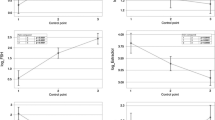Abstract
Testosterone, FSH, LH and prolactin were measured before, and up to 36 months after orchiectomy in 62 patients with prostatic carcinoma; 36 were treated by primary orchiectomy, 10 by orchiectomy after prior estrogen treatment for less than 3 yr (short-term) and 16 for more than 3 yr (long-term). Before orchiectomy serum levels of testosterone, FSH and LH were significantly lower in estrogen-treated than in untreated patients. Following orchiectomy serum FSH and LH increased in all patients studied. However, long-term estrogen-treated patients had significantly lower FSH and LH both before orchiectomy and during the follow-up period than those treated by primary orchiectomy or orchiectomized after short-term estrogen treatment. In addition, in those long-term estrogen-treated patients, serum testosterone did not significantly decrease after orchiectomy, whereas in patients treated by primary orchiectomy or orchiectomized after short-term estrogen treatment serum testosterone fell significantly. At follow-up comparable levels of testosterone were found in the three patient groups studied. Prolactin levels did not differ significantly between the patient groups and were not elevated either before or after orchiectomy. It is suggested that patients with carcinoma of the prostate treated with estrogen for more than 3 yr have impaired, but slowly increasing, pituitary gland function, possibly caused by long-term effect of estrogen on the pituitary gland.
Similar content being viewed by others
References
Huggins C., Hodges C.V. Studies of prostatic cancer. I. The effect of castration, of estrogen and of androgen injection on serum phosphatases in metastastic carcinoma of the prostate. Cancer Res. 1: 293, 1941.
Bracci U., Di Silverio F., Sciarra F., Sorcini G., Piro C., Sandoro F. Hormonal pattern in prostatic carcinoma following orchidectomy: 5 years follow-up. Br. J. Urol. 49: 161, 1977.
Boyns A.R., Cole E.N., Phillips M.E.A., Hillier S.G., Cameron E.H.D., Griffiths K., Shahmanesh M., Feneley R.C., Hartog M. Plasma prolactin, GH, LH, FSH and testosterone during treatment of prostatic carcinoma with oestrogens. Eur. J. Cancer 10: 445, 1974.
Jones T.M., Fang V.S., Landau R.L., Rosenfield R. Direct inhibition of Leydig cell function by estradiol. J. Clin. Endocrinol. Metab. 47: 1368, 1978.
Walsh P.S., Swerdloff R.S., Odell W.D. Feedback control of FSH in male: role of oestrogen. Acta Endocrinol. (Kbh.) 74: 449, 1973.
Tomić R., Bergman B., Damber J.-E. Testicular endocrine function after withdrawl of oestrogen treatment in patients with carcinoma of the prostate. Br. J. Urol. 55: 42, 1983.
Lukkarinen O., Hammond G.L., Konturi M., Vihko R. Long-term effects of endocrine treatment on serum pituitary hormones in advanced prostatic carcinoma patients. Scand. J. Urol. Nephrol. 15: 207, 1981.
Damber J.-E., Janson P.O. The effect of LH, adrenaline and noradrenaline on testicular blood flow and plasma testosterone concentration in aneasthetized rast. Acta Endocrinol. (Kbh.) 88: 399, 1978.
Midgley A.R. Jr. Radioimmunoassay: a method for human chorionic gonadotropin and human luteinizing hormone. Endocrinology 79: 10, 1966.
Odell W.D., Rayford P.L., Ross G.T. Simplified partially automated method for radioimmunoassy of human thyroid stimulating, growth, luteinizing and follicle stimulating hormones. J. Lab. Clin. Med. 70: 973, 1967.
Hwang P., Guyda H., Friesen H. A radioimmunoassay for human prolactin. Proc. Natl. Acad. Sci. USA 68: 1902, 1971.
Siegel S. Non-parametric Statistics for the Behavioral Sciences. McGraw-Hill Book Co., New York, 1956.
Tcholakin R.K., Chowdhuri M., Chowdhuri A.K. Recovery of testicular and pituitary function in adult male rats after cessation of short and long term estradiol treatment. Biol. Reprod. 19: 431, 1973.
Seyler L.E., Reichlin S. Feedback regulation of circulating LRF concentration in men. J. Clin. Endocrinol. Metab. 39: 906, 1974.
Tomić R. Some effects of orchiectomy, oestrogen treatment and radiation therapy in patients with prostatic carcinoma. Scand. J. Urol. Nephrol. (Suppl.) 77, 1983.
Bergman B., Tomić R., Damber J.-E. Long-term follow-up after cessation of oestrogen treatment in prostatic cancer patients. P ostate 4: 429, 1983 (Abstract).
Reynoso G., Murphy G.A. Adrenalectomy and hypophysectomy in advanced prostatic carcinoma. Cancer 29: 941, 1972.
Author information
Authors and Affiliations
Rights and permissions
About this article
Cite this article
TomiĆ, R. Pituitary function after orchiectomy in patients with or without earlier estrogen treatment for prostatic carcinoma. J Endocrinol Invest 10, 479–482 (1987). https://doi.org/10.1007/BF03348174
Received:
Accepted:
Published:
Issue Date:
DOI: https://doi.org/10.1007/BF03348174




